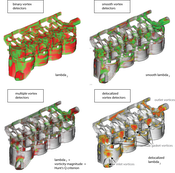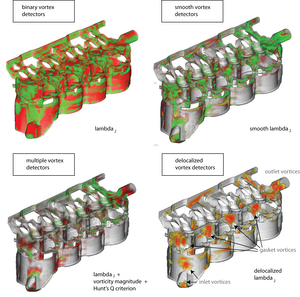Information
- Publication Type: PhD-Thesis
- Workgroup(s)/Project(s):
- Date: October 2008
- Date (Start): June 2006
- Date (End): October 2008
- TU Wien Library:
- Second Supervisor: Ronald Peikert
- Rigorosum: 9. October 2008
- First Supervisor: Helwig Hauser
- Keywords: Interactive Visual Analysis, Vortex Detection, Scientific Visualization
Abstract
Computational simulation of physical and chemical processes has become an essential tool to tackle questions from the field of fluid dynamics. Using current simulation packages it is possible to compute unsteady flow simulations for realistic scenarios. The resulting solutions are stored in large to very large grids in 2D or 3D, frequently time-dependent, with multi-variate results from the numeric simulation. With increasing complexity of simulation results, powerful analysis and visualization tools are needed to make sense of the computed information and answer the question at hand. To do this we need new approaches and algorithms to locate regions of interest, find important structures in the flow and analyze the behavior of the flow interactively.The main motives of this thesis are the extension of vortex detection criteria to unsteady flow and the combination of vortex detectors with interactive visual analysis. To develop an understanding for the simulation results it is necessary to compare attributes of the simulation to each other and to be able to relate them to larger structures such as vortices. It is shown how automatic feature detection algorithms can be combined with interactive analysis techniques such that both detection and analysis benefit.
By extending and integrating vortex detectors into the process of visual analysis, it becomes possible to understand the impact of vortex structures on the development of the flow. Using real-world examples from the field of engine design we discuss how vortex structures can have critical impact on the performance of a prototype. We illustrate how interactive visual analysis can support prototype design and evaluation. Furthermore, we show that taking the unsteady nature of the flow into account improves the quality of the extracted structures.
Additional Files and Images
Additional images and videos
 Figure1:
We illustrate some of the extensions to vortex region analysis discussed throughout this thesis. (1) We start with binary vortex detectors. It is hard to understand where the structures originate and how they are related to the geometry. (2) Using non-binary vortex detectors we can select only the parts of the volume that contain relevant structures. (3) By combining multiple criteria it is possible to refine the selection further and it becomes obvious that the gaskets between cylinder head and body are of critical importance. (4) Using delocalization we can further refine the selection and remove noise from the results.
Figure1:
We illustrate some of the extensions to vortex region analysis discussed throughout this thesis. (1) We start with binary vortex detectors. It is hard to understand where the structures originate and how they are related to the geometry. (2) Using non-binary vortex detectors we can select only the parts of the volume that contain relevant structures. (3) By combining multiple criteria it is possible to refine the selection further and it becomes obvious that the gaskets between cylinder head and body are of critical importance. (4) Using delocalization we can further refine the selection and remove noise from the results.
Additional files
Weblinks
No further information available.BibTeX
@phdthesis{fuchs-vortex,
title = "The Visible Vortex - Interactive Analysis and Extraction of
Vortices in Large Time-Dependent Flow Data Sets",
author = "Raphael Fuchs",
year = "2008",
abstract = "Computational simulation of physical and chemical processes
has become an essential tool to tackle questions from the
field of fluid dynamics. Using current simulation packages
it is possible to compute unsteady flow simulations for
realistic scenarios. The resulting solutions are stored in
large to very large grids in 2D or 3D, frequently
time-dependent, with multi-variate results from the numeric
simulation. With increasing complexity of simulation
results, powerful analysis and visualization tools are
needed to make sense of the computed information and answer
the question at hand. To do this we need new approaches and
algorithms to locate regions of interest, find important
structures in the flow and analyze the behavior of the flow
interactively. The main motives of this thesis are the
extension of vortex detection criteria to unsteady flow and
the combination of vortex detectors with interactive visual
analysis. To develop an understanding for the simulation
results it is necessary to compare attributes of the
simulation to each other and to be able to relate them to
larger structures such as vortices. It is shown how
automatic feature detection algorithms can be combined with
interactive analysis techniques such that both detection and
analysis benefit. By extending and integrating vortex
detectors into the process of visual analysis, it becomes
possible to understand the impact of vortex structures on
the development of the flow. Using real-world examples from
the field of engine design we discuss how vortex structures
can have critical impact on the performance of a prototype.
We illustrate how interactive visual analysis can support
prototype design and evaluation. Furthermore, we show that
taking the unsteady nature of the flow into account improves
the quality of the extracted structures.",
month = oct,
address = "Favoritenstrasse 9-11/E193-02, A-1040 Vienna, Austria",
school = "Institute of Computer Graphics and Algorithms, Vienna
University of Technology ",
keywords = "Interactive Visual Analysis, Vortex Detection, Scientific
Visualization",
URL = "https://www.cg.tuwien.ac.at/research/publications/2008/fuchs-vortex/",
}


 thesis
thesis